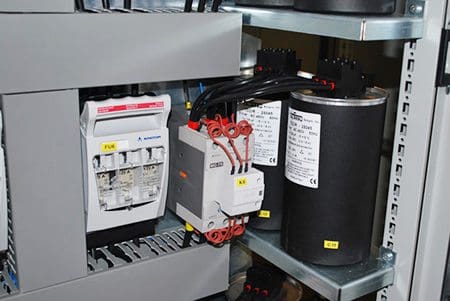Commercial Building Case
Power factor correction and voltage regulation are closely related. In many cases, the desired voltage regulation is costly to obtain. Larger or paralleled conductors to reduce voltage drop under load are, in many cases, the proper solution.

However, power factor correction may also be justified for four reasons:
- To improve voltage
- To lower the cost of electric energy, when the electric utility rates vary with the power factor at the metering point
- To reduce the energy losses in conductors
- To utilize the full capacity of transformers, switches, overcurrent devices, buses, and conductors for active power only, thereby lowering the capital investment and annual costs
Voltage Regulation
The goal of good voltage regulation is to control the voltage of the system so that it will stay within a practical and safe range of voltage tolerances under all design loads. Voltage at any utilization equipment should be within the guaranteed operative range of the equipment.
Voltage regulation in any circuit, expressed in percentage, is:

When it is not economical to control voltage drop through conductor sizing, circuit design, or other means, voltage regulators may be needed. Several types of voltage regulators, either automatic or manual, are available for all types and sizes of loads from individual electronic devices to the equipment for an entire laboratory or department store.
Normally, the power and light distribution system within large commercial buildings can be designed economically and adequately without the use of large voltage regulators.
Power Factor Correction
When the type of load to be installed in the commercial building will result in a poor power factor, then an evaluation should be made to determine if installing capacitors is justified, either to stay within the power factor range specified by the electric utility in order to avoid penalty payments or to obtain a reduction in the electric bill.
When large machines (like blowers, or refrigeration or air compressors) are to be installed, a study should be made to determine whether it would be economical to install a synchronous motor and utilize it for power factor correction.

The cost of the synchronous motor with its controller should be compared with the cost of a squirrel-cage motor with its simpler controls plus separate static capacitors.
Better utilization of electrical machines
Generators and transformers are sized according to the apparent power S. At the same active power P, the smaller the reactive power Q to be delivered, the smaller the apparent power.
Reduction of losses
The power losses of an electric conductor depend on the resistance of the conductor itself and on the square of the current flowing through it.
Since, with the same value of transmitted active power, the higher the cosφ, the lower the current, it follows that when the power factor rises, the losses in the conductor on the supply side of the point where the power factor correction has been carried out will decrease.
Usefull engineer’s stuff
Usefull guides and MS Excel spreadsheets for calculating the Power Factor:
References //
- IEEE Recommended Practice for Electric Power Systems in Commercial Buildings
- Power factor correction and harmonic filtering in electrical plants – ABB











I came upon your website while trying to learn about ‘Power factor regulators’.
I am an ex marine engineer well into retirement. If you have time perhaps you could answer my query, if not, it’s ok too.
Will an average family house in Western Australia benefit from having the local electricity supply fitted with such a device?
Thanks
Michael
dear sir,
thanks alot
Iam electrical engeneer .and intersted in power factor correction
thanks
This is my favorite topic! Switching capacitors in telecom industry affect voltage regulation and phase angle. I came across a case in telecom industry where significant asset damage happened when building was operating on generator and power factor happened to lead. Luckily no one was injured.
Any articles about circulating currents?
Is it possible to install diesel generator 1G on the busbar 30 kV transformers that feed the 30/11 kV?
thank you for your useful and handy informative articles.
I suggest to add some articles about practical problem solutions approved to be routine in electrical industry.